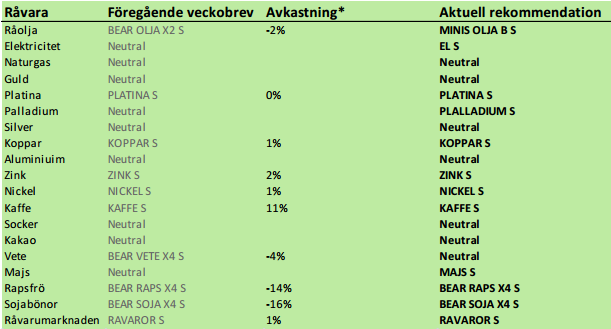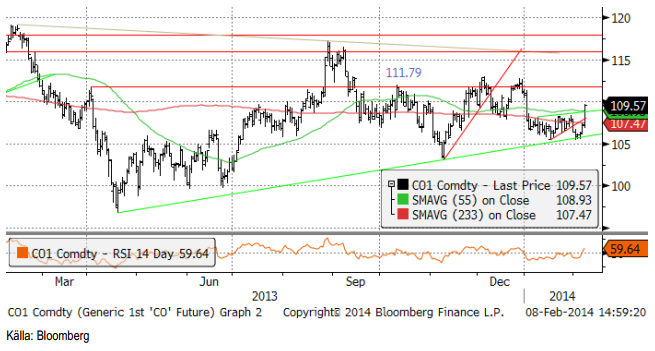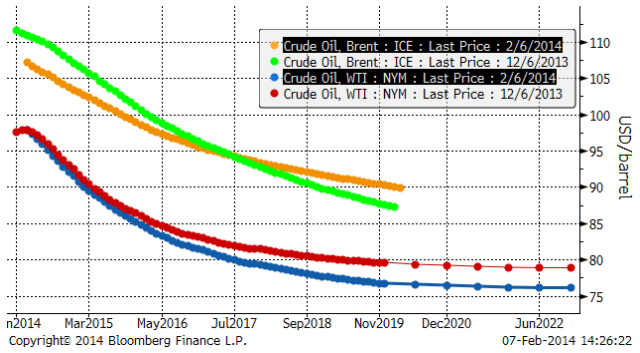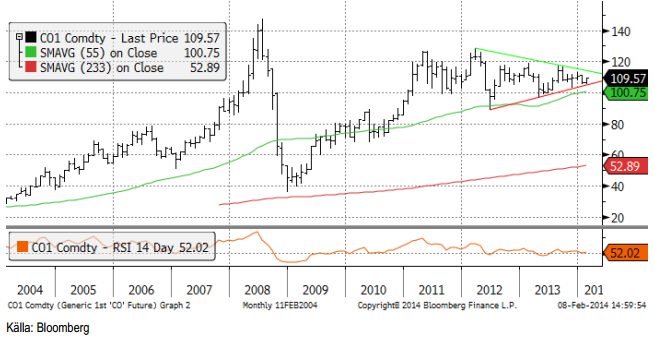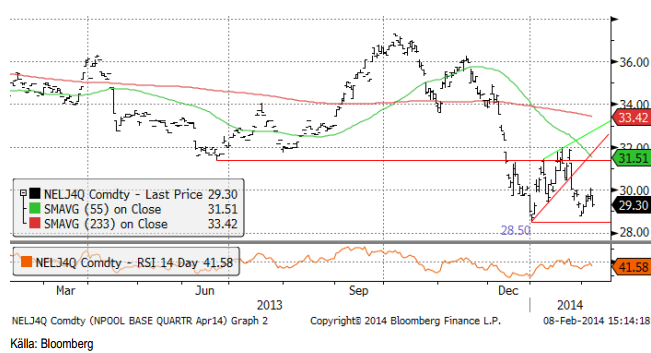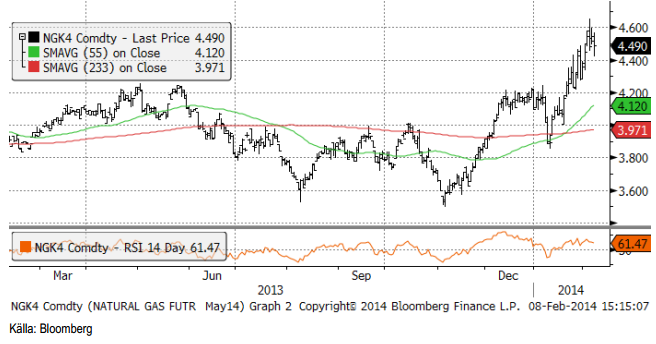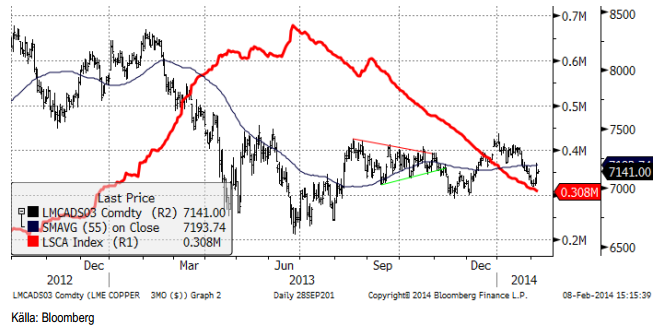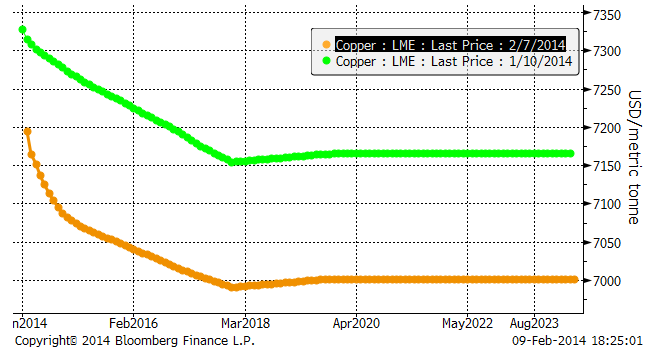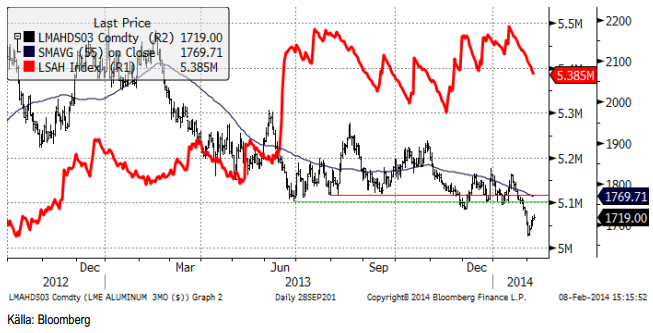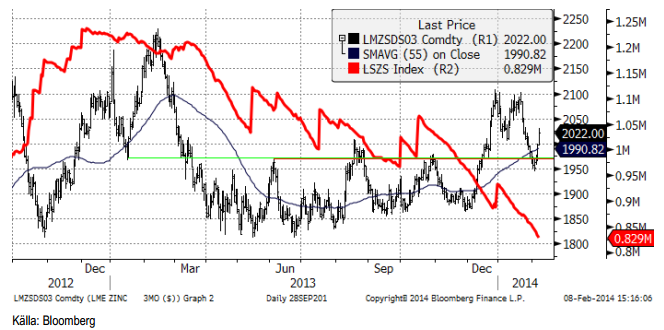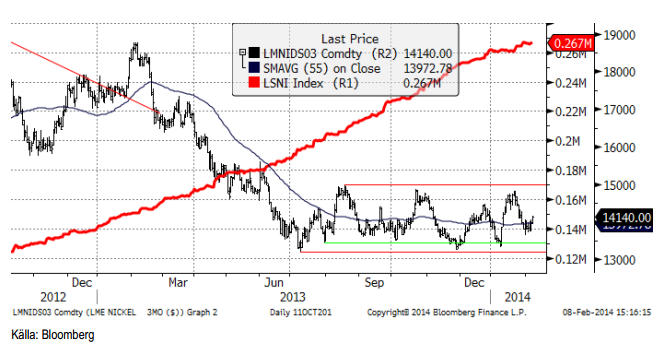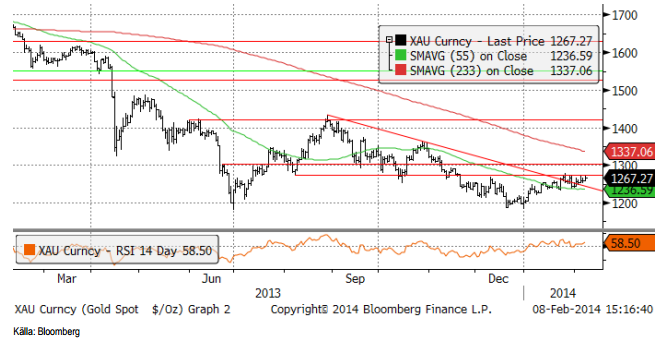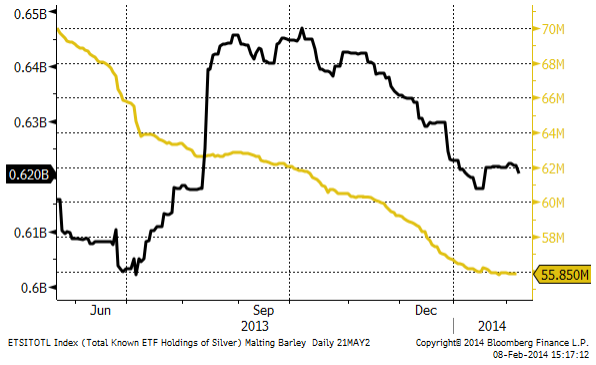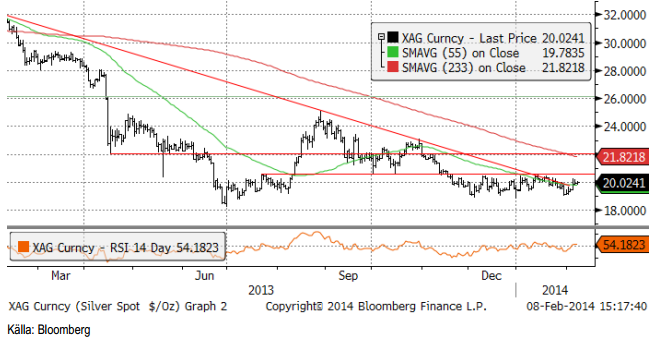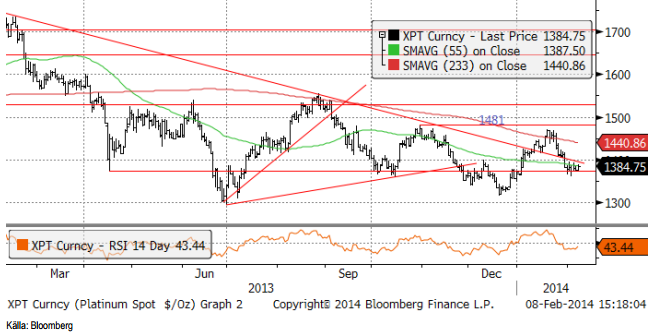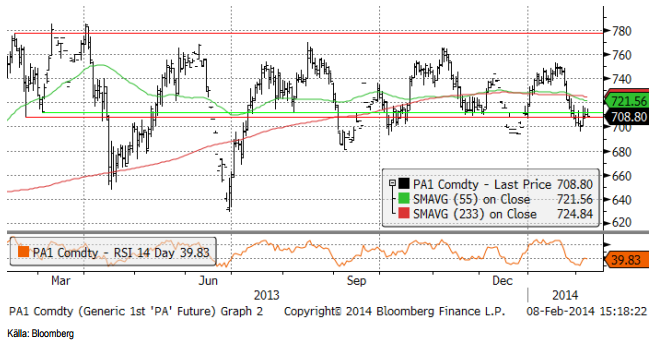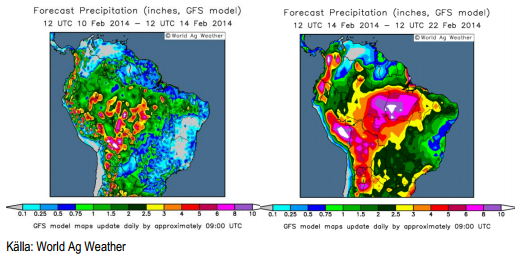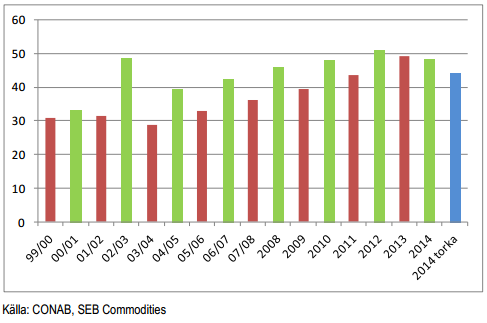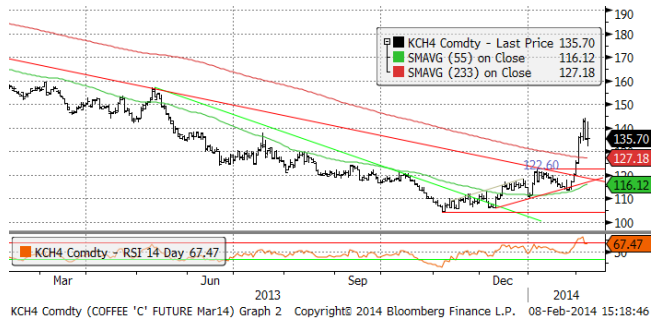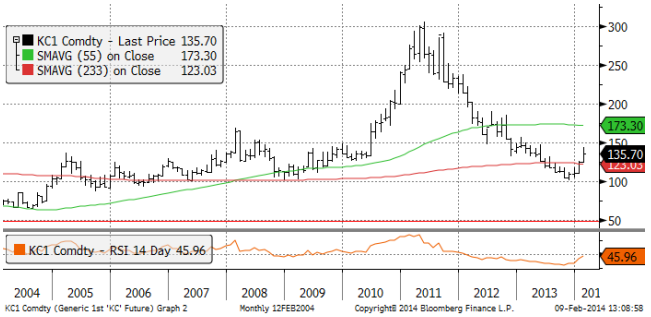Analys
SEB – Råvarukommentarer, 10 februari 2014

Rekommendationer
Inledning
Prisuppgången på kaffe, drivet av torkan i Minas Gerais, som vi skrev om för två veckor sedan, har ökat priset på våra två mini futures med 103 respektive 129%.
Våg två av rapporter – om skadorna – börjar komma nu. Regn är på väg och det kan bli en anledning för marknadsaktörer att ta hem vinster och en rekyl nedåt i priset. Uttömd markfukt, skador på kaffeträden och skador på skörden, gör dock att det finns förutsättningar för en längre ”bull market” i kaffe. Läs mer under kaffe-avsnittet.
Amerikansk arbetsmarknadsstatistik, som publicerades i fredags, var oväntat svag. Antalet nyanställda var 113,000 personer, väsentligt under 180,000 som marknaden väntat sig. Förra månaden var det 75,000 mot väntade nästan 200,000. Medan januaris statistik sågs som en ”glitch”, kan man nu inte bortse från siffrorna. USA:s ekonomi växer inte alls som FED förutsatte när de inledde sin nedtrappning av penningmängdsexpansionen (tapering) strax före Jul. Marknaden tänker sig nu att FED ska minska takten på sin ”tapering” eller rentav ta tillbaka den minskning som gjorts. Vi ska dock komma ihåg att FED:s tro att mer pengar i cirkulation ska ha en effekt på realekonomin inte delas av alla ekonomer. Monetarister menar att mer pengar endast försämrar pengarnas köpkraft, förr eller senare. Non-Farm Payrolls statistiken fick WTI-oljan att stiga över 100 dollar för första gången i år och drog med sig brent-oljan upp. Guldet påverkades dock inte alls.
Basmetallerna koppar och zink börjar uppvisa positiva tecken. Lagren faller, terminsmarknaden går mer in i backwardation och tekniskt har de köpsignaler. Det ser inte lika positivt ut för aluminium, men nickel som är väl understödd tekniskt kan få draghjälp av koppar och zink.
Vi går över till köprekommendation på majs och går över till neutral på vete. Det amerikanska jordbruksdepartementet publicerar sina månatliga estimat på utbud och efterfrågan på spannmål och oljeväxter i USA och i resten av världen ikväll klockan 18. Analytiker väntar sig en ”bullish” rapport.
Råolja – Brent
Oljepriset steg kraftigt i fredags kväll. Marknaden gjorde tolkningen att FED kommer att vara mer expansiv och göra mindre ”tapering” än de tidigare annonserat, efter att arbetsmarknadsstatistiken återigen varit oväntat svag. Prisuppgången i fredags beror sannolikt på att några som satsat stort på ett trendbrott nedåt, valde att köpa tillbaka sina korta positioner. Fundamentalt i världen talar balanserna för ett trendbrott, men det blev inte nu. Det återigen ganska höga priset är dock en ny bra startpunkt för en kort position i oljepriset.
Amerikansk råolja ”WTI”, har de senaste veckorna haft stöd av den extrema kylan i landet, som gjort att diesellagren nu är på sin lägsta nivå på 10 år. I USA ställer raffinaderierna nu om för sommarproduktion. Det innebär att efterfrågan på råolja är låg fram till april. Råoljelagren kommer att öka under den här tiden, vilket gör att marknaden blir orolig. Nuförtiden finns en pipeline, Keystone South, som förbinder Cushing i Oklahoma med Gulfkusten. Lagren har inte ökat i Cushing, däremot har de ökat tre veckor i rad vid gulfkusten. När dessa lager nu är fulla, kommer överskottet att lagras i Cushing och hamna i den DOE-statistik som alla på marknaden följer.
Det har varit en bristsituation på diesel, inte minst pga efterfrågan på eldningsolja i USA. Under våren kommer ny dieselkapacitet i drift om 700,000 fat. Raffinaderikapaciteten ligger i Asien, men den ökade produktionen av diesel på global basis lättar ändå trycket på den amerikanska och europeiska marknaden.
Vi har sett WTI handla upp mot Brent, men med ovanstående kunskaper i bakfickan, tror vi att WTI kommer att falla. Gulf-crudes kommer under press och det sätter i sin tur brentoljan under press.
Terminskurvorna har rört sig på ett mycket intressant sätt de senaste två månaderna. I diagrammet nedan ser vi att Brent (de två övre) har fått en flackare terminskurva. Den korta änden har fallit samtidigt som den långa gått upp. Det är ett tecken på större utbud av olja nu. Den amerikanska WTI-oljan har däremot hamnat ännu mer i backwardation. De längre kontrakten har fallit kraftigt, och i kontrast till brentoljan. Bakom ligger ökade förväntningar på att skifferoljan kommer att öka i betydelse. Samtidigt har inte spotpriset på amerikansk råolja rört sig alls. Orsaken är naturligtvis det kalla vädret, som hållit efterfrågan uppe. Priset för ett fat råolja i USA år 2019 (om fem år) är 15 dollar lägre än priset på ett fat Brent.
Fracking är till 99% en amerikansk företeelse, men USA har bara 9% av alla hittills kända skifferoljeresurser på jorden. Det är rimligt att tänka sig att den här tekniken kommer att sprida sig. Brent ser mot det perspektivet alldeles för dyrt ut. Fracking är idag lönsamt ner till ett oljepris på 45 dollar. Utvecklingen går snabbt. De tre senaste åren har producerad volym per borr rigg trefaldigats, vilket i princip är detsamma som att kostnaden minskat till en tredjedel. Teknikutvecklingen går rasande snabbt. Naturligtvis kommer takten i teknikutvecklingen att avta, men å andra sidan har den geografiska spridningen av tekniken börjat.
Vi ser i månadsdiagrammet nedan, att ett brott nedåt (eller uppåt, också en möjlighet) inte är långt borta.
Vi rekommenderar en kort position i oljepriset, t ex med BEAR OLJA X2 S eller mini future ”MINIS OLJA B S”. ”MINIS OLJA B S” har stopp-loss vid 115 dollar per fat. Den ökar med 79% i värde om oljepriset faller med 10%.
Elektricitet
Elpriset bröt rekylen uppåt i slutet av januari och föll ner till årsskiftets bottennivå vid 28.50 euro för en vecka sedan. Därifrån en rekyl upp till 30 euro, där priset vände ner i fredags. Ett nytt test av stödet vid 28.50 verkar troligt ur teknisk synvinkel.
Prognosen för hydrologisk balans har legat still den senaste veckan på -1.8 TWh. För Norden som helhet är magasinfyllnaden 55.1% och det ska jämföras med medianvärdet som är 58.1% för vecka 5. Elanvändningen i Sverige var åt det låga hållet i veckan som gick, 3.4 TWh där de senaste 20 årens intervall varit 3.2 – 3.8 TWh. Elproduktionen var 3.8 TWh. Kärnkraften gick på 95% av den installerade effekten i Norden. Det är endast Oskarshamn 2 som är avstängd, liksom tidigare.
Terminspriset för leverans av kol nästa år har fallit från 87 dollar till 82.30. Priset är alltså tillbaka på bottennivåerna från oktober. Priset ligger under produktionskostnaden för gruvorna i Australien, Sydamerika och Kanada. Den australiensiska dollar har under samma period fallit med 8% mot US-dollarn, så där är en av förklaringarna till varför kolpriset inte har stigit i US-dollartermer.
Den 6 februari fattade EU beslut om att tillhandahålla utsläppsrätter för 400 miljoner ton mindre än tidigare planerade 300 miljoner ton. Det kallas för ”backloading”. Dels minskar utbudet av utsläppsrätter redan i år med 100 miljoner ton, vilket var oväntat mycket och dels är den politiska signalen till marknaden central. EU vill att marknaden ska finnas kvar och att priset ska vara signfikant. Ett pris på 5 euro per ton, där priset låg fram till mitten av januari var uppenbarligen för lågt för EU:s politiker. Vi tror inte att dagens pris på 6.59 euro per ton är den prisnivå som EU tänker på, utan snarare 10 euro och kanske 15 euro. Det är helt tydligt nu att marknaden för utsläppsrätter INTE är en fri marknad, utan en politiskt styrd marknad, där den politiska styrningen är avgörande för priset.
Allt annat lika skulle en fördubbling av priset på utsläppsrätter ge ett elpris som är 33% högre.
EU fattade också beslut om att slopa de nationella målen för minskningen i CO2-utsläpp. Frankrike, Tyskland, Italien och Spanien har alla, liksom Sverige, förbundit sig att minska utsläppen med 40% till 2013 och 80% till 2050. Detta behöver de inte göra längre, utan minskningen ska ske på EU-nivå, heter det. EU politikerna i Bryssel kallar det för ”flexibilitet”. Det innebär i praktiken att det är fritt fram för dessa länder att brassa på med kolkraft, givet att man har utsläppsrätter. Den nye tyske finansministern Sigmar Gabriel har sagt att de förnybara energikällorna har blivit en ”albatross runt halsen på industrin” så att de kan leda till en ”avindustrialisering” av Tyskland. Förbundskansler Angela Merkel har tidigare sagt att en för stor andel förnybar elproduktion kan leda till problem med energitillförseln.
Vi tycker att priset på el kommit ner så långt att vi väljer att gå tillbaka till en köprekommendation. Då volatiliteten är hög och vi tror att den kommer att fortsätta att vara det, är inte BULL-certifikat bäst, utan EL S eller om man vill ta mer risk, en ”mini long” mini future. Bäst är att försöka köp om terminspriset kommer ner mot 28.50. Går priset under 28.50 måste man dock gå ur (stop loss).
Naturgas
Ordentligt kallt väder i USA har ökat efterfrågan på gas och minskat lagren, vilket får ytterligare kallt väder att direkt påverka priset. Sedan början på november har priset på maj-terminen gått upp med 1 hel dollar från 3.60 per MMBtu till 4.60.
Koppar
Koppar, liksom andra basmetaller, köptes upp inför årsskiftet och det hotande exportstoppet av malm från Indonesien. Det var ett klassiskt fall av ”buy on rumour, sell on fact”. Priset föll tillbaka, men inte hela vägen ner. Tekniskt har vi en köpsignal sedan uppgången i december. Rekylen nedåt ska därför betraktas som ett köptillfälle.
Efterfrågan på koppar i världen är större än utbudet, vilket visar sig i de fallande lagren på LME. Lagret på 308,000 ton är på en nivå där det tidigare talats om brist på material. Även terminskurvan uppvisar tilltagande tecken på brist. Sedan den 10 januari, en månad sedan, ligger priserna visserligen lägre, men graden av backwardation har ökat. Det är ett ”bullish” tecken. Den som investerar i koppar nu via terminsmarknaden kan förvänta sig stigande pris och kan också göra investeringen i terminer som handlas till rabatt i förhållande till spotpriset. Vi ser detta i terminskurvorna nedan (10 januari och i fredags 7 februari).
Vi rekommenderar köp av KOPPAR S.
Aluminium
Aluminium, den svagaste bland basmetallerna, föll under den tekniska stödnivån under januari. Sedan dess har priset rekylerat upp, samtidigt som lagren sjunkit. Vi skulle ändå inte vilja köpa aluminium än.
Vi fortsätter med neutral rekommendation på aluminium.
Zink
Priset på zink rekylerade ner till stödnivån vid 1950 dollar och vände sedan uppåt i veckan. Lagren fortsätter att rasa i en skrämmande takt. Lagren är visserligen fortfarande stora, men i den här takten når de noll om drygt ett år.
Vi rekommenderar köp av ZINK S eller BULL ZINK X4 S.
Nickel
Lagren av nickel fortsätter att öka, trots exportstoppet av malm från Indonesien. Priset verkar vara väl understött, men motståndet vid 15000 dollar per ton har inte brutits än och såsom lagersituationen utvecklar sig är nickel inte lika ”bullish” som koppar och zink. Just nu ligger dock nickelpriset på tekniskt stöd vid 14,140 dollar och bör kunna gå upp till 15,000 dollar. En köpt position i BULL NICKEL X4 S bör kunna ha goda möjligheter att bli en lönsam placering, givet detta.
Guld
Guldet borde ha reagerat med stigande pris efter Non-Farm Payrolls, som råoljepriset gjorde. Nu lyckades inte guldmarknaden handla positivt, när den borde det, och det är ett negativt tecken. Priset ligger precis under ett tekniskt stöd på 1270, som det inte lyckats ta sig över den senaste månaden.
Fysiska handlare av investeringsguld säger att de sålt lika mycket hittills i år som under hela förra året. Skrotningen av gamla smycken har helt torkat upp, dels för att priset är så lågt och dels antagligen för att reserverna hos folk har tömts. På den fysiska sidan, i alla fall i Sverige, är efterfrågan på fysiskt guld alltså stark, samtidigt som utbudet av skrot minskat kraftigt. För att par år sedan var skrotningen av smycken i Sverige mycket större än efterfrågan på guld, investeringsguld inräknat. Detta ser nu helt annorlunda ut.
Det ökande intresset för att köpa investeringsguld syns även i ETF-statistiken. Fondernas innehav av guld har slutat minska från mitten av januari och kurvan har planat ut vid 56 miljoner uns.
Vi fortsätter tills vidare med neutral vy på guld. Tecknen på en vändning till det positiva har ökat, men det är negativt att priset inte steg på NFP-statistiken i fredags.
Silver
Silver fortsätter att ligga under ett tekniskt motstånd. Priset är har också gott stöd på nedsidan. Som vi sett ovanför fortsätter placerare att sälja andelar i börshandlade fonder på silver, men detta tycks inte ha någon negativ effekt på priset.
Vi fortsätter med neutral vy på silver, till dess vi får en tydlig teknisk signal.
Platina & Palladium
Platina orkade inte över det tekniska motståndet vid 1481 dollar och vände ner till det tekniska stödet, som hittills har hållit. Vi tycker att det här är ett köptillfälle.
Palladium föll också tillbaka och stängde i fredags på 708.8 cent. Vi tycker att palladium är köpvärt på den här nivån.
Vi rekommenderar alltså köp av både platina och palladium.
Kaffe
För två veckor kunde du här läsa utförligt om torkan i de brasilianska delstaterna Minas Gerais och Espirito Santo, som är centrum för kaffeproduktionen i landet och därmed i världen. Torkan har fortsatt och det är klart att årets kommande skörd blir mindre än förväntat. Det talas också om att nästa års skörd också kommer att påverkas, i kanske ännu större utsträckning. I fredags kom dock de första väderleksrapporterna med nederbörd för området. Somar Meteorologia skrev i en emailad rapport i fredags att torkan kommer att bestå under den första halvan av februari. Därefter kommer de kallfronter som finns över Argentina och Uruguay att röra sig norrut och med kallare väder och nederbörd.
Vi ser skillnaden mellan prognosticerad nederbörd för perioden 10 – 12 februari respektive 14 – 22 februari. I den vänstra (fram till 14 februari) är det mycket blått över Minas Gerais och Espirito Santo, vilket betyder extremt lite nederbörd. I bilden till höger är det mer grönt och gult, som indikerar 1 – 3 tum nederbörd.
Förra årets skörd som var klar i oktober var enligt CONAB 49.2 miljoner säckar (om 60 Kg). Årets skörd har estimerats till 48.3 miljoner säckar, men det står klart att torkan kommer att minska det. Ett odlingskooperativ i Brasilien som heter Cooparaiso säger att deras skörd kan hamna på 2.7 – 2.8 miljoner säckar istället för 3 miljoner. Om vi överför den minskningen på 8.5% till hela Brasilien skulle det innebära att skörden blir 44.2 miljoner säckar istället för 48.3.
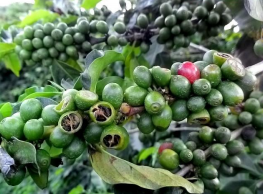 Det finns dock andra rapporter, som pekar på en ännu lägre skörd. I södra Minas Gerais finns rapporter om fenomenet som kallas ”Coracao Negro”, eller ”svart hjärta. När man delar på kaffebären finns där två små vissnade, torkade och svarta bönor, som inte duger för att göra kaffe av. En lantbrukare, intervjuad av Bloomberg, sade berättade att han trodde att skörden skulle bli minst 30% mindre än normalt. Förra året hade han sålt hela sin skörd – i år ingenting, eftersom han inte vet om han kommer att ha något att sälja. Nedanför ser vi en bild på ”Coracao Negro”.
Det finns dock andra rapporter, som pekar på en ännu lägre skörd. I södra Minas Gerais finns rapporter om fenomenet som kallas ”Coracao Negro”, eller ”svart hjärta. När man delar på kaffebären finns där två små vissnade, torkade och svarta bönor, som inte duger för att göra kaffe av. En lantbrukare, intervjuad av Bloomberg, sade berättade att han trodde att skörden skulle bli minst 30% mindre än normalt. Förra året hade han sålt hela sin skörd – i år ingenting, eftersom han inte vet om han kommer att ha något att sälja. Nedanför ser vi en bild på ”Coracao Negro”.
Lantbrukarna hade ställt in sig på att priset skulle bli lågt. Därför beskar man träden innan blomningen i oktober. Torkan har dock gjort att de beskurna träden inte växer. I de fält som har nyplanterats har plantorna vissnat i.
Normalt sett är det regnperiod fram till april och därefter torrt fram till september. I Minas Gerais har det inte regnat sedan december och det är mycket ovanligt. Det innebär att markfukten, reserverna som behövs under april till september, inte finns där. För att återställa markfukten behöver det regna mycket mer än normalt fram till dess.
Nedan ser vi ett diagram på skörden i Brasilien i antal miljoner säckar. Arabica i Brasilien är en ”vartannatårsgröda”. Gröna år är de med hög skörd och röda de med lägre. Skörden i somras (mellan april och oktober) var en skörd som var lägre, men rekordhög för att vara en sådan. Det pressade priset på kaffe förra året. Årets skörd ska vara en hög, men förutspåddes i januari av CONAB att bli lägre än förra årets skörd. Det var innan torkans effekt uppmärksammades. Den blåa stapeln längst till höger, visar en 9% lägre skörd (som torkan kan medföra).
En skörd på 9% innebär att globala lager, allt annat lika, inte ökar som tidigare väntat, utan stannar på samma nivå. Blir skörden ännu lägre, som vi har sett att det finns indikationer på, blir lagren lägre. Effekten av torkan är inte heller begränsad till en skörd och ett år, utan kommer att ha en effekt på produktionen även nästa år.
Priset på kaffe rusade upp när informationen om torkan väl sjönk in (långt efter att du kunde läsa om det här för två veckor sedan). Priset gick från 113 cent den 27 januari till 144.15 i torsdags den 6 februari. Vi ska komma ihåg att produktionskostnaden ligger på 147 cent i år, enligt en rapport från USDA. Medan priset ännu ligger under produktionskostnaden är det trots allt så att det strukturellt råder överproduktion av kaffe på global basis. På kort sikt tycker vi att kaffepriset är fullvärderat och vi tror att marknaden kommer att ta hem vinster.
På lite längre sikt än det allra mest kortsiktiga, tror vi att kaffeprisets fallande trend är slut och att effekten av torkan i Brasilien har skyndat på vändningen i kaffemarknaden. På lite längre sikt rekommenderar vi köp av kaffe. I nedanstående diagram ser vi prisutvecklingen de senaste tio åren. Kan man köpa på ca
Vi rekommenderar att man tar hem sina vinster på mycket kort sikt och försöker köpa ner mot 130 cent. En rekyl nedåt kan vara förestående, föranlett av såväl kommande nederbörd som vinsthemtagningar och i så fall ta ner priset till 122 – 127 cent, men i en stark marknad kanske priset inte når ner dit. Generellt sett behåller vi köprekommendationen på kaffe.
Det finns nu också mini futures från SEB på kaffe, som erbjuder högre hävstång.
Se även analysbrevet på övriga jordbruksråvaror från SEB.
[box]SEB Veckobrev Veckans råvarukommentar är producerat av SEB Merchant Banking och publiceras i samarbete och med tillstånd på Råvarumarknaden.se[/box]
Disclaimer
The information in this document has been compiled by SEB Merchant Banking, a division within Skandinaviska Enskilda Banken AB (publ) (“SEB”).
Opinions contained in this report represent the bank’s present opinion only and are subject to change without notice. All information contained in this report has been compiled in good faith from sources believed to be reliable. However, no representation or warranty, expressed or implied, is made with respect to the completeness or accuracy of its contents and the information is not to be relied upon as authoritative. Anyone considering taking actions based upon the content of this document is urged to base his or her investment decisions upon such investigations as he or she deems necessary. This document is being provided as information only, and no specific actions are being solicited as a result of it; to the extent permitted by law, no liability whatsoever is accepted for any direct or consequential loss arising from use of this document or its contents.
About SEB
SEB is a public company incorporated in Stockholm, Sweden, with limited liability. It is a participant at major Nordic and other European Regulated Markets and Multilateral Trading Facilities (as well as some non-European equivalent markets) for trading in financial instruments, such as markets operated by NASDAQ OMX, NYSE Euronext, London Stock Exchange, Deutsche Börse, Swiss Exchanges, Turquoise and Chi-X. SEB is authorized and regulated by Finansinspektionen in Sweden; it is authorized and subject to limited regulation by the Financial Services Authority for the conduct of designated investment business in the UK, and is subject to the provisions of relevant regulators in all other jurisdictions where SEB conducts operations. SEB Merchant Banking. All rights reserved.
Analys
Tightening fundamentals – bullish inventories from DOE

The latest weekly report from the US DOE showed a substantial drawdown across key petroleum categories, adding more upside potential to the fundamental picture.

Commercial crude inventories (excl. SPR) fell by 5.8 million barrels, bringing total inventories down to 415.1 million barrels. Now sitting 11% below the five-year seasonal norm and placed in the lowest 2015-2022 range (see picture below).
Product inventories also tightened further last week. Gasoline inventories declined by 2.1 million barrels, with reductions seen in both finished gasoline and blending components. Current gasoline levels are about 3% below the five-year average for this time of year.
Among products, the most notable move came in diesel, where inventories dropped by almost 4.1 million barrels, deepening the deficit to around 20% below seasonal norms – continuing to underscore the persistent supply tightness in diesel markets.
The only area of inventory growth was in propane/propylene, which posted a significant 5.1-million-barrel build and now stands 9% above the five-year average.
Total commercial petroleum inventories (crude plus refined products) declined by 4.2 million barrels on the week, reinforcing the overall tightening of US crude and products.


Analys
Bombs to ”ceasefire” in hours – Brent below $70

A classic case of “buy the rumor, sell the news” played out in oil markets, as Brent crude has dropped sharply – down nearly USD 10 per barrel since yesterday evening – following Iran’s retaliatory strike on a U.S. air base in Qatar. The immediate reaction was: “That was it?” The strike followed a carefully calibrated, non-escalatory playbook, avoiding direct threats to energy infrastructure or disruption of shipping through the Strait of Hormuz – thus calming worst-case fears.

After Monday morning’s sharp spike to USD 81.4 per barrel, triggered by the U.S. bombing of Iranian nuclear facilities, oil prices drifted sideways in anticipation of a potential Iranian response. That response came with advance warning and caused limited physical damage. Early this morning, both the U.S. President and Iranian state media announced a ceasefire, effectively placing a lid on the immediate conflict risk – at least for now.
As a result, Brent crude has now fallen by a total of USD 12 from Monday’s peak, currently trading around USD 69 per barrel.
Looking beyond geopolitics, the market will now shift its focus to the upcoming OPEC+ meeting in early July. Saudi Arabia’s decision to increase output earlier this year – despite falling prices – has drawn renewed attention considering recent developments. Some suggest this was a response to U.S. pressure to offset potential Iranian supply losses.
However, consensus is that the move was driven more by internal OPEC+ dynamics. After years of curbing production to support prices, Riyadh had grown frustrated with quota-busting by several members (notably Kazakhstan). With Saudi Arabia cutting up to 2 million barrels per day – roughly 2% of global supply – returns were diminishing, and the risk of losing market share was rising. The production increase is widely seen as an effort to reassert leadership and restore discipline within the group.
That said, the FT recently stated that, the Saudis remain wary of past missteps. In 2018, Riyadh ramped up output at Trump’s request ahead of Iran sanctions, only to see prices collapse when the U.S. granted broad waivers – triggering oversupply. Officials have reportedly made it clear they don’t intend to repeat that mistake.
The recent visit by President Trump to Saudi Arabia, which included agreements on AI, defense, and nuclear cooperation, suggests a broader strategic alignment. This has fueled speculation about a quiet “pump-for-politics” deal behind recent production moves.
Looking ahead, oil prices have now retraced the entire rally sparked by the June 13 Israel–Iran escalation. This retreat provides more political and policy space for both the U.S. and Saudi Arabia. Specifically, it makes it easier for Riyadh to scale back its three recent production hikes of 411,000 barrels each, potentially returning to more moderate increases of 137,000 barrels for August and September.
In short: with no major loss of Iranian supply to the market, OPEC+ – led by Saudi Arabia – no longer needs to compensate for a disruption that hasn’t materialized, especially not to please the U.S. at the cost of its own market strategy. As the Saudis themselves have signaled, they are unlikely to repeat previous mistakes.
Conclusion: With Brent now in the high USD 60s, buying oil looks fundamentally justified. The geopolitical premium has deflated, but tensions between Israel and Iran remain unresolved – and the risk of missteps and renewed escalation still lingers. In fact, even this morning, reports have emerged of renewed missile fire despite the declared “truce.” The path forward may be calmer – but it is far from stable.
Analys
A muted price reaction. Market looks relaxed, but it is still on edge waiting for what Iran will do

Brent crossed the 80-line this morning but quickly fell back assigning limited probability for Iran choosing to close the Strait of Hormuz. Brent traded in a range of USD 70.56 – 79.04/b last week as the market fluctuated between ”Iran wants a deal” and ”US is about to attack Iran”. At the end of the week though, Donald Trump managed to convince markets (and probably also Iran) that he would make a decision within two weeks. I.e. no imminent attack. Previously when when he has talked about ”making a decision within two weeks” he has often ended up doing nothing in the end. The oil market relaxed as a result and the week ended at USD 77.01/b which is just USD 6/b above the year to date average of USD 71/b.

Brent jumped to USD 81.4/b this morning, the highest since mid-January, but then quickly fell back to a current price of USD 78.2/b which is only up 1.5% versus the close on Friday. As such the market is pricing a fairly low probability that Iran will actually close the Strait of Hormuz. Probably because it will hurt Iranian oil exports as well as the global oil market.
It was however all smoke and mirrors. Deception. The US attacked Iran on Saturday. The attack involved 125 warplanes, submarines and surface warships and 14 bunker buster bombs were dropped on Iranian nuclear sites including Fordow, Natanz and Isfahan. In response the Iranian Parliament voted in support of closing the Strait of Hormuz where some 17 mb of crude and products is transported to the global market every day plus significant volumes of LNG. This is however merely an advise to the Supreme leader Ayatollah Ali Khamenei and the Supreme National Security Council which sits with the final and actual decision.
No supply of oil is lost yet. It is about the risk of Iran closing the Strait of Hormuz or not. So far not a single drop of oil supply has been lost to the global market. The price at the moment is all about the assessed risk of loss of supply. Will Iran choose to choke of the Strait of Hormuz or not? That is the big question. It would be painful for US consumers, for Donald Trump’s voter base, for the global economy but also for Iran and its population which relies on oil exports and income from selling oil out of that Strait as well. As such it is not a no-brainer choice for Iran to close the Strait for oil exports. And looking at the il price this morning it is clear that the oil market doesn’t assign a very high probability of it happening. It is however probably well within the capability of Iran to close the Strait off with rockets, mines, air-drones and possibly sea-drones. Just look at how Ukraine has been able to control and damage the Russian Black Sea fleet.
What to do about the highly enriched uranium which has gone missing? While the US and Israel can celebrate their destruction of Iranian nuclear facilities they are also scratching their heads over what to do with the lost Iranian nuclear material. Iran had 408 kg of highly enriched uranium (IAEA). Almost weapons grade. Enough for some 10 nuclear warheads. It seems to have been transported out of Fordow before the attack this weekend.
The market is still on edge. USD 80-something/b seems sensible while we wait. The oil market reaction to this weekend’s events is very muted so far. The market is still on edge awaiting what Iran will do. Because Iran will do something. But what and when? An oil price of 80-something seems like a sensible level until something do happen.
-

 Nyheter3 veckor sedan
Nyheter3 veckor sedanMahvie Minerals växlar spår – satsar fullt ut på guld
-

 Nyheter4 veckor sedan
Nyheter4 veckor sedanUppgången i oljepriset planade ut under helgen
-

 Nyheter4 veckor sedan
Nyheter4 veckor sedanLåga elpriser i sommar – men mellersta Sverige får en ökning
-

 Nyheter3 veckor sedan
Nyheter3 veckor sedanOljan, guldet och marknadens oroande tystnad
-

 Analys3 veckor sedan
Analys3 veckor sedanA muted price reaction. Market looks relaxed, but it is still on edge waiting for what Iran will do
-

 Nyheter3 veckor sedan
Nyheter3 veckor sedanJonas Lindvall är tillbaka med ett nytt oljebolag, Perthro, som ska börsnoteras
-

 Analys4 veckor sedan
Analys4 veckor sedanVery relaxed at USD 75/b. Risk barometer will likely fluctuate to higher levels with Brent into the 80ies or higher coming 2-3 weeks
-

 Nyheter3 veckor sedan
Nyheter3 veckor sedanDomstolen ger klartecken till Lappland Guldprospektering


